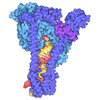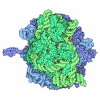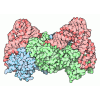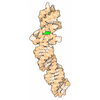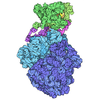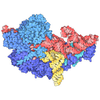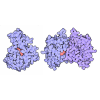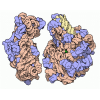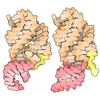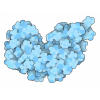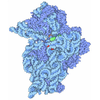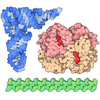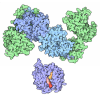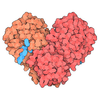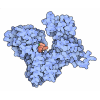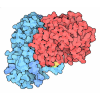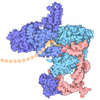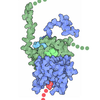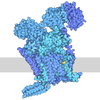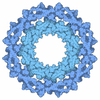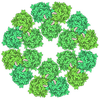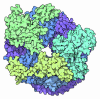[English] 日本語
 Yorodumi
Yorodumi- PDB-8gwo: A mechanism for SARS-CoV-2 RNA capping and its inhibition by nucl... -
+ Open data
Open data
- Basic information
Basic information
| Entry | Database: PDB / ID: 8gwo | ||||||||||||||||||||||||||||||||||||||||||||||||
|---|---|---|---|---|---|---|---|---|---|---|---|---|---|---|---|---|---|---|---|---|---|---|---|---|---|---|---|---|---|---|---|---|---|---|---|---|---|---|---|---|---|---|---|---|---|---|---|---|---|
| Title | A mechanism for SARS-CoV-2 RNA capping and its inhibition by nucleotide analogue inhibitors | ||||||||||||||||||||||||||||||||||||||||||||||||
 Components Components |
| ||||||||||||||||||||||||||||||||||||||||||||||||
 Keywords Keywords | VIRAL PROTEIN / SARS-CoV-2 / capping / nucleotide analogue inhibitor / cryo-EM | ||||||||||||||||||||||||||||||||||||||||||||||||
| Function / homology |  Function and homology information Function and homology informationviral genome replication / methyltransferase activity / protein guanylyltransferase activity / RNA endonuclease activity producing 3'-phosphomonoesters, hydrolytic mechanism / mRNA guanylyltransferase activity / 5'-3' RNA helicase activity / Lyases; Phosphorus-oxygen lyases / Assembly of the SARS-CoV-2 Replication-Transcription Complex (RTC) / symbiont-mediated suppression of host cytoplasmic pattern recognition receptor signaling pathway via inhibition of TBK1 activity / Maturation of replicase proteins ...viral genome replication / methyltransferase activity / protein guanylyltransferase activity / RNA endonuclease activity producing 3'-phosphomonoesters, hydrolytic mechanism / mRNA guanylyltransferase activity / 5'-3' RNA helicase activity / Lyases; Phosphorus-oxygen lyases / Assembly of the SARS-CoV-2 Replication-Transcription Complex (RTC) / symbiont-mediated suppression of host cytoplasmic pattern recognition receptor signaling pathway via inhibition of TBK1 activity / Maturation of replicase proteins / TRAF3-dependent IRF activation pathway / ISG15-specific peptidase activity / Transcription of SARS-CoV-2 sgRNAs / snRNP Assembly / Translation of Replicase and Assembly of the Replication Transcription Complex / Replication of the SARS-CoV-2 genome / Hydrolases; Acting on ester bonds; Exoribonucleases producing 5'-phosphomonoesters / double membrane vesicle viral factory outer membrane / host cell endoplasmic reticulum-Golgi intermediate compartment / SARS coronavirus main proteinase / 5'-3' DNA helicase activity / 3'-5'-RNA exonuclease activity / endonuclease activity / host cell endosome / symbiont-mediated degradation of host mRNA / mRNA guanylyltransferase / symbiont-mediated suppression of host ISG15-protein conjugation / G-quadruplex RNA binding / symbiont-mediated suppression of host toll-like receptor signaling pathway / symbiont-mediated suppression of host cytoplasmic pattern recognition receptor signaling pathway via inhibition of IRF3 activity / methylation / omega peptidase activity / mRNA (guanine-N7)-methyltransferase / methyltransferase cap1 / SARS-CoV-2 modulates host translation machinery / host cell Golgi apparatus / symbiont-mediated suppression of host NF-kappaB cascade / symbiont-mediated perturbation of host ubiquitin-like protein modification / DNA helicase / methyltransferase cap1 activity / ubiquitinyl hydrolase 1 / cysteine-type deubiquitinase activity / mRNA 5'-cap (guanine-N7-)-methyltransferase activity / Hydrolases; Acting on peptide bonds (peptidases); Cysteine endopeptidases / single-stranded RNA binding / regulation of autophagy / viral protein processing / lyase activity / host cell perinuclear region of cytoplasm / host cell endoplasmic reticulum membrane / RNA helicase / symbiont-mediated suppression of host type I interferon-mediated signaling pathway / symbiont-mediated suppression of host gene expression / copper ion binding / viral translational frameshifting / symbiont-mediated activation of host autophagy / RNA-directed RNA polymerase / cysteine-type endopeptidase activity / viral RNA genome replication / RNA-directed RNA polymerase activity / DNA-templated transcription / lipid binding / host cell nucleus / SARS-CoV-2 activates/modulates innate and adaptive immune responses / ATP hydrolysis activity / proteolysis / RNA binding / zinc ion binding / ATP binding / membrane Similarity search - Function | ||||||||||||||||||||||||||||||||||||||||||||||||
| Biological species |  synthetic construct (others) | ||||||||||||||||||||||||||||||||||||||||||||||||
| Method | ELECTRON MICROSCOPY / single particle reconstruction / cryo EM / Resolution: 3.8 Å | ||||||||||||||||||||||||||||||||||||||||||||||||
 Authors Authors | Yan, L.M. / Huang, Y.C. / Ge, J. / Liu, Z.Y. / Gao, Y. / Rao, Z.H. / Lou, Z.Y. | ||||||||||||||||||||||||||||||||||||||||||||||||
| Funding support |  China, 2items China, 2items
| ||||||||||||||||||||||||||||||||||||||||||||||||
 Citation Citation |  Journal: Cell / Year: 2022 Journal: Cell / Year: 2022Title: A mechanism for SARS-CoV-2 RNA capping and its inhibition by nucleotide analog inhibitors. Authors: Liming Yan / Yucen Huang / Ji Ge / Zhenyu Liu / Pengchi Lu / Bo Huang / Shan Gao / Junbo Wang / Liping Tan / Sihan Ye / Fengxi Yu / Weiqi Lan / Shiya Xu / Feng Zhou / Lei Shi / Luke W Guddat ...Authors: Liming Yan / Yucen Huang / Ji Ge / Zhenyu Liu / Pengchi Lu / Bo Huang / Shan Gao / Junbo Wang / Liping Tan / Sihan Ye / Fengxi Yu / Weiqi Lan / Shiya Xu / Feng Zhou / Lei Shi / Luke W Guddat / Yan Gao / Zihe Rao / Zhiyong Lou /    Abstract: Decoration of cap on viral RNA plays essential roles in SARS-CoV-2 proliferation. Here, we report a mechanism for SARS-CoV-2 RNA capping and document structural details at atomic resolution. The ...Decoration of cap on viral RNA plays essential roles in SARS-CoV-2 proliferation. Here, we report a mechanism for SARS-CoV-2 RNA capping and document structural details at atomic resolution. The NiRAN domain in polymerase catalyzes the covalent link of RNA 5' end to the first residue of nsp9 (termed as RNAylation), thus being an intermediate to form cap core (GpppA) with GTP catalyzed again by NiRAN. We also reveal that triphosphorylated nucleotide analog inhibitors can be bonded to nsp9 and fit into a previously unknown "Nuc-pocket" in NiRAN, thus inhibiting nsp9 RNAylation and formation of GpppA. S-loop (residues 50-KTN-52) in NiRAN presents a remarkable conformational shift observed in RTC bound with sofosbuvir monophosphate, reasoning an "induce-and-lock" mechanism to design inhibitors. These findings not only improve the understanding of SARS-CoV-2 RNA capping and the mode of action of NAIs but also provide a strategy to design antiviral drugs. | ||||||||||||||||||||||||||||||||||||||||||||||||
| History |
|
- Structure visualization
Structure visualization
| Structure viewer | Molecule:  Molmil Molmil Jmol/JSmol Jmol/JSmol |
|---|
- Downloads & links
Downloads & links
- Download
Download
| PDBx/mmCIF format |  8gwo.cif.gz 8gwo.cif.gz | 498.8 KB | Display |  PDBx/mmCIF format PDBx/mmCIF format |
|---|---|---|---|---|
| PDB format |  pdb8gwo.ent.gz pdb8gwo.ent.gz | 397.9 KB | Display |  PDB format PDB format |
| PDBx/mmJSON format |  8gwo.json.gz 8gwo.json.gz | Tree view |  PDBx/mmJSON format PDBx/mmJSON format | |
| Others |  Other downloads Other downloads |
-Validation report
| Summary document |  8gwo_validation.pdf.gz 8gwo_validation.pdf.gz | 1.6 MB | Display |  wwPDB validaton report wwPDB validaton report |
|---|---|---|---|---|
| Full document |  8gwo_full_validation.pdf.gz 8gwo_full_validation.pdf.gz | 1.7 MB | Display | |
| Data in XML |  8gwo_validation.xml.gz 8gwo_validation.xml.gz | 88.7 KB | Display | |
| Data in CIF |  8gwo_validation.cif.gz 8gwo_validation.cif.gz | 135.9 KB | Display | |
| Arichive directory |  https://data.pdbj.org/pub/pdb/validation_reports/gw/8gwo https://data.pdbj.org/pub/pdb/validation_reports/gw/8gwo ftp://data.pdbj.org/pub/pdb/validation_reports/gw/8gwo ftp://data.pdbj.org/pub/pdb/validation_reports/gw/8gwo | HTTPS FTP |
-Related structure data
| Related structure data |  34318MC 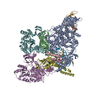 8gw1C  8gwbC 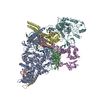 8gweC 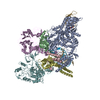 8gwfC 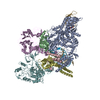 8gwgC 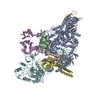 8gwiC 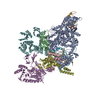 8gwkC 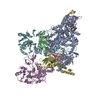 8gwmC 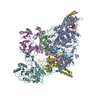 8gwnC M: map data used to model this data C: citing same article ( |
|---|---|
| Similar structure data | Similarity search - Function & homology  F&H Search F&H Search |
- Links
Links
- Assembly
Assembly
| Deposited unit | 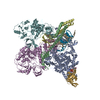
|
|---|---|
| 1 |
|
- Components
Components
-Protein , 2 types, 3 molecules AFE
| #1: Protein | Mass: 106780.977 Da / Num. of mol.: 1 / Fragment: UNP residues 4393-5324 Source method: isolated from a genetically manipulated source Source: (gene. exp.)  Production host:  |
|---|---|
| #6: Protein | Mass: 66930.531 Da / Num. of mol.: 2 / Fragment: UNP residues 5325-5925 Source method: isolated from a genetically manipulated source Source: (gene. exp.)  Production host:  |
-Non-structural protein ... , 3 types, 4 molecules BDCG
| #2: Protein | Mass: 21903.047 Da / Num. of mol.: 2 / Fragment: UNP residues 3943-4140 Source method: isolated from a genetically manipulated source Source: (gene. exp.)  Gene: rep, 1a-1b / Production host:  #3: Protein | | Mass: 9248.804 Da / Num. of mol.: 1 / Fragment: UNP residues 3860-3942 Source method: isolated from a genetically manipulated source Source: (gene. exp.)  Production host:  #7: Protein | | Mass: 12391.171 Da / Num. of mol.: 1 / Fragment: UNP residues 4141-4253 Source method: isolated from a genetically manipulated source Details: Uridine monophosphate bound to to N-terminal of chain G Source: (gene. exp.)  Production host:  |
|---|
-RNA chain , 2 types, 2 molecules IJ
| #4: RNA chain | Mass: 8172.932 Da / Num. of mol.: 1 / Source method: obtained synthetically / Source: (synth.) synthetic construct (others) |
|---|---|
| #5: RNA chain | Mass: 10443.209 Da / Num. of mol.: 1 / Source method: obtained synthetically / Source: (synth.) synthetic construct (others) |
-Non-polymers , 3 types, 10 molecules 
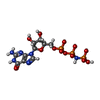
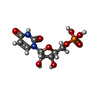


| #8: Chemical | ChemComp-ZN / #9: Chemical | ChemComp-GNP / | #10: Chemical | ChemComp-U5P / | |
|---|
-Details
| Has ligand of interest | Y |
|---|---|
| Has protein modification | Y |
-Experimental details
-Experiment
| Experiment | Method: ELECTRON MICROSCOPY |
|---|---|
| EM experiment | Aggregation state: PARTICLE / 3D reconstruction method: single particle reconstruction |
- Sample preparation
Sample preparation
| Component |
| ||||||||||||||||||||||||
|---|---|---|---|---|---|---|---|---|---|---|---|---|---|---|---|---|---|---|---|---|---|---|---|---|---|
| Source (natural) | Organism:  | ||||||||||||||||||||||||
| Source (recombinant) | Organism:  | ||||||||||||||||||||||||
| Buffer solution | pH: 7 | ||||||||||||||||||||||||
| Specimen | Embedding applied: NO / Shadowing applied: NO / Staining applied: NO / Vitrification applied: YES | ||||||||||||||||||||||||
| Vitrification | Cryogen name: ETHANE |
- Electron microscopy imaging
Electron microscopy imaging
| Experimental equipment |  Model: Titan Krios / Image courtesy: FEI Company |
|---|---|
| Microscopy | Model: FEI TITAN KRIOS |
| Electron gun | Electron source:  FIELD EMISSION GUN / Accelerating voltage: 300 kV / Illumination mode: FLOOD BEAM FIELD EMISSION GUN / Accelerating voltage: 300 kV / Illumination mode: FLOOD BEAM |
| Electron lens | Mode: BRIGHT FIELD / Nominal defocus max: 1200 nm / Nominal defocus min: 1000 nm |
| Image recording | Electron dose: 60 e/Å2 / Film or detector model: GATAN K2 QUANTUM (4k x 4k) |
- Processing
Processing
| Software | Name: PHENIX / Version: 1.20.1_4487: / Classification: refinement | ||||||||||||||||||||||||
|---|---|---|---|---|---|---|---|---|---|---|---|---|---|---|---|---|---|---|---|---|---|---|---|---|---|
| EM software | Name: PHENIX / Category: model refinement | ||||||||||||||||||||||||
| CTF correction | Type: PHASE FLIPPING AND AMPLITUDE CORRECTION | ||||||||||||||||||||||||
| 3D reconstruction | Resolution: 3.8 Å / Resolution method: FSC 0.143 CUT-OFF / Num. of particles: 2058771 / Symmetry type: POINT | ||||||||||||||||||||||||
| Refine LS restraints |
|
 Movie
Movie Controller
Controller











 PDBj
PDBj